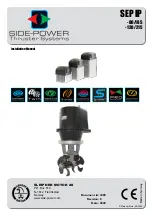
www.d
fi
.com
38
Chapter 3 BIOS Setup
Chapter 3
www.d
fi
.com
38
Chapter 3 BIOS Setup
Security
When Hidden, don’t ex-
poses TPM to 0
Current TPM Device
TPM State
TPM Availability
TPM Operation
Clear TPM
Supervisor Password
Set Supervisor Password
Main
Advanced
F1
Help
↑
/
↓
Select Item
F5/F6
Change Values
F9
Setup Defaults
Esc
Exit
←
/
→
Select Item
Enter
Select
SubMenu
F10
Save and Exit
InsydeH2O Setup Utility
Security
Boot
Exit
Rev. 5.0
<TPM 2.0 (FTPM)>
All Hierarchies Enabled, UnOwned
<Available>
<No Operation>
[ ]
Not installed
TPM Availability
Show or hide the TPM availability and its configurations.
TPM Operation
Enable or disable the TPM function. It displays the following options:
No Operation
No changes to current state.
Enable
Enable and activate TPM.
Clear TPM
Remove all TPM context associated with a specific owner.
Set Supervisor Password
Set the supervisor’s password and the length of the password must be greater than
one character.
Boot
Selects Power-on state for
Numlock
Numlock
Boot Type
Network Stack
PXE Boot capability
USB Boot
Quiet Boot
Main
Advanced
F1
Help
↑
/
↓
Select Item
F5/F6
Change Values
F9
Setup Defaults
Esc
Exit
←
/
→
Select Item
Enter
Select
SubMenu
F10
Save and Exit
InsydeH2O Setup Utility
Security
Exit
Rev. 5.0
<On>
<Dual Boot Type>
<Disabled>
<Disabled>
<Enabled>
<Disabled>
Boot
Numlock
Select the power-on state for numlock.
Boot Type
Select the boot type. The options are Dual Boot Type, Legacy Boot Type or UEFI Boot
Type.
If you select “Dual Boot Type” or “UEFI Boot Type”, the “Network Stack”, “PXE Boot
capability”, “USB Boot” and “Quiet Boot” will show up.
If you select “Legacy Boot Type”, “PXE Boot to LAN”, “USB Boot” and “Quiet Boot” will
show up.
Network Stack
This field is used to enable or disable network stack.
PXE Boot capability
Disabled
Suppoort Network Stack
UEFI
IPv4/IPv6
Legacy
Legacy PXE OPROM only
Note:
If the boot type is set to UEFI, the method for RAID volume creation will be different.
Please refer to Chapter 5
˗
RAID for more information.
















































